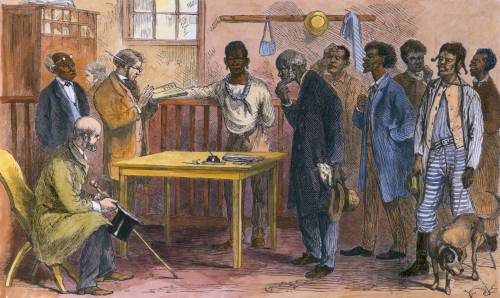
History, 31.01.2022 17:40 maiacheerz
Semester Review and Exam Practice
1. The early reports from Christopher Columbus, Hernán Cortés, and other early explorers about initial contact with Native Americans suggests that they
A. needed Native American help to build ports along important shipping routes.
B. viewed Native American civilizations as fundamentally useless for their aims.
C. intended to establish mutually beneficial trading relations with native peoples.
D. saw the Americas as a land of wealth that might be conquered with little resistance.
2. How did Triangle Trade influence economic activities in the British colonies?
A. The colonies focused on the production of goods most demanded by different trade partners.
B. The colonies focused on the export of resources available in their region and demanded by Britain.
C. The colonies focused on trade with Native Americans to obtain needed resources to send overseas.
D. The colonies focused on growing their local economies by exchanging goods and resources with one another.
3. The British forces found themselves besieged at Yorktown because they
A. retreated from a failed invasion of New York.
B. failed to occupy and take control of Southern states.
C. were caught by a surprise winter attack led by Washington.
D. were cut off from support when they lost their hold on Boston.
4. Which of the following elements of the constitution was the product of compromise?
A. the role of the president as Commander in Chief
B. the power to tax at the federal level
C. the freedom of speech and freedom of religion
D. the bicameral Congress with proportional and equal representation
5. What territorial gains did the United States make as a result of the Mexican-American War? Select all that apply.
A. California
B. Gadsden Purchase
C. Louisiana Territory
D. Nebraska Territory
E. New Mexico
6. Which statement BEST describes a cause of the nullification crisis in 1832?
A. Northern states wanted to protect their industries by imposing tariffs.
B. Southern states wanted to force Northern states to uphold the fugitive slave laws.
C. Southern states wanted to defend their economic interests by not enforcing tariffs.
D. Northern states refused to uphold fugitive slave laws that violated the principles of their own laws.
7. Which of the following cities became the center of the country’s growing Irish population in the mid-nineteenth century?
A. Charleston
B. New Orleans
C. New York
D. Chicago
8. How did the Panic of 1857 contribute to sectional tensions?
A. It sparked renewed disagreement over protective tariffs.
B. It triggered a sudden spike in the cost of Southern cotton.
C. It brought about a Southern depression and widespread poverty in the South.
D. It led to a stock market crash in the North and calls for a boycott of Northern goods.
9. Which series correctly summarizes the events leading up to the onset of the Civil War?
A. Lincoln was elected; several Southern states seceded; South Carolina seized Fort Sumter; Lincoln called up troops; more states seceded.
B. Lincoln was elected; several Southern states seceded; Lincoln called up troops; more states seceded; South Carolina seized Fort Sumter.
C. South Carolina seized Fort Sumter; several Southern states seceded; Lincoln was elected; more states seceded; Lincoln called up troops.
D. Several Southern states seceded; Lincoln was elected; Lincoln called up troops; South Carolina seized Fort Sumter; more states seceded.
10.Which of the following BEST explains how the Battle of Gettysburg set off a chain of events leading to the end of the Civil War?
A. The Confederate win galvanized Union forces and rallied Grant’s armies to encircle Lee.
B. Lee’s loss ended any chance of invading the North and put the Confederates on retreat.
C. Grant’s victory gave the Union control of the Mississippi River and divided Confederate forces.
D. Sherman’s “scorched earth” policies razed the Confederate countryside, destroying supplies and morale.
11. Use the image to answer the question.
During which period of Reconstruction would one MOST LIKELY have observed this scene?
A. Lincoln’s Ten Percent Plan
B. Johnson’s Presidential Reconstruction
C. Radical Republicans’ Congressional Reconstruction
D. the post-1877 Redemption period
12. Who was MOST LIKELY to support the implementation of Jim Crow laws in the South? Select all that apply.
A. freed black citizens
B. former Confederate officials
C. carpetbaggers and scalawags
D. African American elected officials
E. members of white supremacist groups


Answers: 3


Other questions on the subject: History

History, 21.06.2019 13:30, jamiehorton2000
Arrange the events in the order with they occured.
Answers: 1

History, 21.06.2019 18:30, moose12002
The line dividing regions 4 & 5 on this map is known as the "fall line." which of these represents an important factor of the fall line in georgia history? a) it was the first boundary of the georgia after it became a state. b) it was an important source of power due to a change in elevation. c) it was once home to major cities that have since become abandoned. d) it was a dividing line between the united states and native american territories.
Answers: 1

History, 22.06.2019 00:50, labrandonanderson00
Those who resisted the mongol invaders were attacked and their towns burned; those who cooperated with them also were attacked and had their towns burned. were treated fairly. were taken into the tribes and treated as mongols. were sent away to find new homes.
Answers: 2

History, 22.06.2019 02:00, neariah24
Determine whether the following descriptions belong to michelangelo, raphael, or both. important works include school of athens was a renowned artist of the italian renaissance served under the patronage of pope leo x important works include the sculpture la pieta
Answers: 3
You know the right answer?
Semester Review and Exam Practice
1. The early reports from Christopher Columbus, Hernán Cortés, a...
Questions in other subjects:












